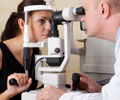Cataract detectiona can be made much earlier than before, with significant reduction in incidence of vision loss, using a compact fibre-optic probe that was initially developed in America for a space program.
Researchers from the National Eye Institute (NEI), part of the National Institutes of Health, joined hands with their colleagues from the National Aeronautics and Space Administration (NASA) to develop the simple, safe eye test for measuring a protein related to cataract formation.The researchers say that helping people know about subtle protein changes before a cataract develops may encourage them to reduce their risk of contracting the condition by making simple lifestyle changes, such as decreasing sun exposure, quitting smoking, stopping certain medications and controlling diabetes.
"By the time the eye's lens appears cloudy from a cataract, it is too late to reverse or medically treat this process. This technology can detect the earliest damage to lens proteins, triggering an early warning for cataract formation and blindness," said Manuel B. Datiles III, M.D., NEI medical officer and lead author of the clinical study.
According to the researchers, the novel device is based on a laser light technique called dynamic light scattering (DLS). It was initially developed to analyse the growth of protein crystals in a zero-gravity space environment, they reveal.
NASA's Rafat R. Ansari, a senior scientist at the John H. Glenn Research Center and co-author of the study, is the man who brought it to the attention of NEI vision researchers that the technology could possibly have clinical applications too.
He conceived that idea after learning that his own father's cataracts were caused by changes in lens proteins.
Advertisement
However, humans are born with a fixed amount of alpha-crystallin, and therefore a depleted supply cause by radiation exposure, smoking, diabetes or other causes can result in a cataract.
Advertisement
"By understanding the role of protein changes in cataract formation, we can use the lens not just to look at eye disease, but also as a window into the whole body," the researcher added.
The recent NEI-NASA clinical trial looked at 380 eyes of people, aged 7 to 86, who had lenses ranging from clear to severe cloudiness from cataract. The researchers used the DLS device to shine a low-power laser light through the lenses.
The team had already determined alpha-crystallin's light-scattering ability, which was then used to detect and measure the amount of alpha-crystallin in the lenses.
They observed that as cloudiness increased, alpha-crystallin in the lenses decreased.
According to the researchers, alpha-crystallin amounts also decreased as the participants' ages increased, even when the lenses were still transparent, and that such age-related pre-cataract changes would remain undetected by currently available imaging tools.
"This research is a prime example of two government agencies sharing scientific information for the benefit of the American people. At an individual level, this device could be used to study the effectiveness of anti-cataract therapies or the tendency of certain medications to cause cataract formation," said NEI director Paul A. Sieving, M.D., Ph.D.
The researchers reckon that the DLS technique may be helpful in looking at long-term lens changes due to aging, smoking, diabetes, LASIK surgery, eye drops for treating glaucoma, and surgical removal of the vitreous gel within the eye, a procedure known to cause cataracts within six months to one year.
They say that this approach may also be helpful in the early diagnosis of Alzheimer's disease, in which an abnormal protein may be found in the lens.
Meanwhile, NASA will continue using the device to look at the impact of long-term space travel on the visual system.
"During a three year mission to Mars, astronauts will experience increased exposure to space radiation that can cause cataracts and other problems. In the absence of proper countermeasures, this may pose a risk for NASA. This technology could help us understand the mechanism for cataract formation so we can work to develop effective countermeasures to mitigate the risk and prevent it in astronauts," Dr. Ansari said.
A research article describing the study has been published in the Archives of Ophthalmology.
Source-ANI
TAN












